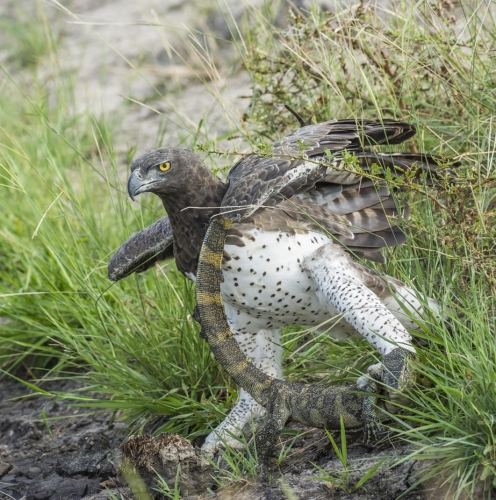Conservation in the digital age: Google Images reveals the diet of Africa’s largest eagle


Adult male Martial Eagle (Polemaetus bellicosus) with a white-tailed mongoose (Ichneumia albicauda) kill photographed in Kenya. Credit: Riaan Marais
Researchers from the Department of Biological Sciences at UCT, Vincent Naude and Associate Professor Arjun Amar have used Google Images to track the dietary habits of Africa’s largest eagle, the Martial Eagle, gaining new information from regions where the species has never been studied before.
In a paper published this week in the international journal The Condor, scientists use photos sourced from the web to reveal the bird’s main prey types, information that may help conservationists protect this threatened species.
“Very little research has been done on the diet of Marital Eagles, leaving huge gaps in our understanding of how prey abundance is impacting their populations and what we can do about it,” says UCT’s Vincent Naude, lead author of the paper.
“Meanwhile, hundreds of online users who post their photos have inadvertently been collecting intense field data over many years that could help answer these conservation questions.”
The study used the free web-application MORPHIC, which was also developed at UCT, to search for photographs of Martial Eagles with prey that had been uploaded to websites, social media and photography platforms. Researchers trawled through 4,872 photos, 254 of which were used to extract data on eagle location, age, feeding position and type of prey.
The photos were taken from across southern and eastern Africa, including South Africa, Kenya, Namibia, Botswana and Tanzania. They revealed that reptiles, birds and mammals each make up a third of the Marital Eagle’s diet. They also showed that the proportions of prey types varied between different regions of Africa, with mammals dominating in eastern Africa but reptiles being more important in southern Africa.

Adult female Martial Eagle (Polemaetus bellicosus) with rock monitor (Varanus albigularis) kill photographed in Kenya Credit: Riaan Marais
“We’ve been able to paint a picture of what Martial Eagles feed on over a huge geographic scale without many of the biases of previous methods. And we’re doing it at a fraction of the time and expense that would be required using traditional methods,” says Naude.
This is the first research exploring Martial Eagle diet beyond the borders of South Africa, where earlier studies were based. It is also the first time information on their diet has been obtained without looking at prey remains, a practice that requires scientists to find nests in the field and physically examine and identify prey remains, such as bones or feathers.
“Prey remains studies are costly and limited by the low-density of these huge eagles. They also limit our understanding to diet during the breeding season where males are the primary hunters. These previous approaches also exclude information about non-breeding eagles which could be important for understanding why this eagle is in decline,” says Naude.
The Martial Eagle is the largest eagle in Africa, weighing up to 6.5kg (14lbs). In 2013 it was up-listed to ‘vulnerable’ on the International Union for Conservation of Nature’s (IUCN) Red List of Threatened Species due to declines throughout its range.
One explanation for the decline is a reduction in available prey. According to Associate Professor Arjun Amar, who supervised the research, “The information we have gathered in this study can help investigate whether shortage of prey might be contributing to the decline and also help guide conservation efforts in these different regions.”
“For example, we now know that reptiles are the eagle’s most important prey in eastern South Africa. Conservationists can use that information to investigate what factors affect the abundance of reptiles in that region and what can be done to protect them,” he says.
The scientists say Google Images could help inform conservation efforts for other species under threat, from raptors to big cats, as long as they are photographed widely over their range.
“With very little expense, scientists can tap into this online resource and contribute to the global conservation of a species,” says Naude. “It’s a powerful take on citizen science that could shape many aspects of future research.”
Article title and access:
“Using web-sourced photography to explore the diet of a declining African raptor, the Martial Eagle Polemaetus bellicosus”
